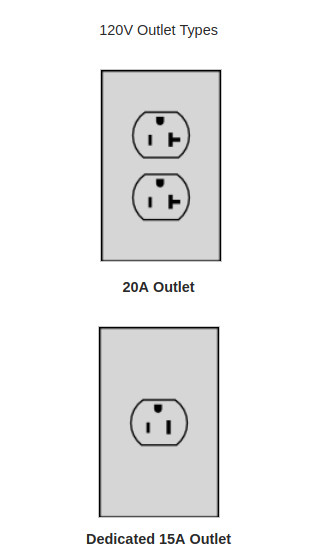
About 10 minutes from room temperature to 320°F (which is our typical grilling temperature). To reach 425°F takes 13-15 minutes.
*Note: you do not need to preheat when grilling or smoking -- in fact, starting your meats on a cold grill is the preferred method.
Our larger grills (Stately, Signature, and Built-In) are rated at 1750 watts and pull nearly 15 amps at 120 volts*. These grills require either a 20 amps circuit or a dedicated 15 amps outlet.
The smaller models (Metro and Road-Runner) are rated at 1500 watts and can use any standard 120V* outlet.
*Note: You must use a grounded outlet, and generally, a GFCI (Ground-Fault Circuit Interrupter) outlet is recommended. This government fact sheet [3.2 Ground-Fault Circuit-Interrupters (GFCIs)] explains the basics, while Wikipedia gives further details.)
*Terminology:
“110V” and “120V” are used interchangeably (at least in the US); they refer to the exact same thing. A “110V” outlet is also a “120V” outlet and vice versa.
“A” is shorthand for “Amp”
“V” is shorthand for “Volt”
“W” is shorthand for “Watt”
Yes. You may leave it outside year-round. The grill is weatherproof and UV protected. It can be stored in temperatures down to –40° F. A grill cover is optional, but will better protect the finish and help keep it clean.
Grates (occasionally): Many owners prefer to leave them slightly dirty for a char flavor and nice grill marks; use a grill scraper to remove the worst of it. NEVER use a metal bristle brush to clean grates; here's why. If you prefer them clean, soak for ½ hour (or overnight) in hot, soapy water, then scrub with a scouring pad. Oven-cleaner also works well (place in black plastic trash bag, spray liberally, and let soak overnight -- grease wipes away easily in the morning), or you may use a dishwasher, self-cleaning oven, or high-pressure washer.
Drip Pan (seldom): Clean same as grates, or for easiest cleaning, line with aluminum foil. Wrap foil tight around edges & poke hole in center for grease to drain.
Meat Probe (as needed): Clean with a damp cloth or scouring pad, but do not pull on the rubber cord. Do not immerse in water.
Grill Interior (rarely): Moisten tough spots, then scrub with hot, soapy water. Oven cleaner or degreaser also works well, but keep it off the external powder-coat paint. Can let soap or degreaser sit overnight -- grease easily wipes away the next day.
Grill Exterior (as you see fit): Use soap and water to remove dirt & grime, then spray “Rubbermaid Stainless Steel Cleaner” onto stainless-steel. Buff with the grain, using a paper towel or soft cloth; rougher items leave scratches. (Menard's carries this and other stainless steel cleaners; they all work well.)
With a bit of elbow-grease, even the dirtiest Dakota Grill™ can look brand-new!
Soap and water is preferred for most parts of the grill. You can wash the grates, drip pan, and smoker tray in a sink and may use an all-purpose degreaser or scrubber pads. The rest of the grill can be cleaned with a damp cloth when needed. Another simple way to clean your grates and drip pan are to remove them from your grill, place them in a black plastic trash bag, spray them liberally with Easy Off Oven Cleaner, let them soak overnight and then clean very easily the next morning with a Scotchbrite pad and a little soapy water. Works great!
Dakota Grills™ are in a new class of "BBQ ovens" all by themselves. Similar to an oven in that they are insulated and have precise temperature controls, Dakota Grills™ are built around the concepts of barbecue. Simply put, ovens are not designed for ‐ and are among the poorer methods of ‐ cooking meats; whereas Dakota Grills™ are engineered for barbecue and are built to be the best of the best.
Detailed Comparison of a Dakota Grill™ vs. an oven:
The inventors of the Dakota Grill™ married many concepts from grilling, smoking, baking, and barbecuing to arrive at a versatile and easy-to-use appliance which produces incredibly good food.
This is one of the oldest debates in cooking and one of the most commonly held myths about cooking meat. If the piece of meat you are cooking were like a water balloon then piercing the meat would cause liquids to escape and dry out food.
Meat, however, is not like a water balloon. Meat is much more like millions of water balloons. A fork piercing into the meat may damage some of those balloons (cells), but not enough to significantly influence the moisture level of the meat. While a couple of stabs with a fork won't make a big difference, a few dozen will, so keep it to a minimum.
In fact, the most damaging thing you can do to a piece of meat, apart from overcooking, is to freeze it or to microwave it. Freezing causes ice crystals to form in the cells themselves, which ruptures cell membranes, causing cells to leak moisture. Microwaving generates excessive localized heat, primarily near the outer edges, causing intracellular pressures to rise until cells burst, spewing moisture.
When you thaw a piece of frozen meat, or warm leftovers with a microwave (if you must), slower is better. In the case of frozen meat, slow thawing (as opposed to rapid thawing or cooking) gives time for cells to reabsorb some of their lost moisture. For a microwave, lower settings give time for extreme localized heat to dissipate further into the meat -- fewer cells will burst since localized heating is less severe.
Yes! Dakota Grills represented the State of South Dakota at the 2019 National Made in America Product Show at the White House. Watch the interview.
44136 200th St.
Lake Preston, SD 57249
View Location Map
